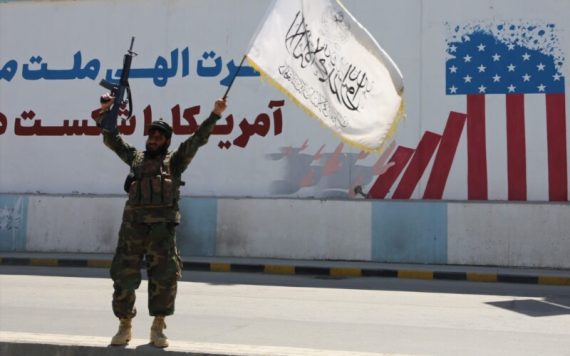T
he Taliban unveiled their plan to build hundreds of religious schools across the country which would result in the raising of the third and fourth generations of radicals. Additionally, the group is turning educational institutions into religious schools and curricula into a fastidious form of religion. Strategically, this would help them fortify the bases of their regime. On the other hand, Afghans are fed up with the strict rules the Taliban impose on people without providing any services to the public. The sudden flip from freedom to a restricted life under the Taliban is worrisome for Afghans.
The group banned education and work for women, and millions of Afghans have either fled or strive to flee the country with some joining resistance forces against the group. Additionally, unemployment and poverty are at their peak. No single country has recognized the group. Reportedly, unknown aircraft circle above the Taliban daily and target Al Qaida and Daesh fighters. Will the Taliban survive? How long will their regime last?
The Taliban government could last more than five years
The Taliban’s harsh regime makes people obedient. When anyone protests them, they quickly disappear. Additionally, the Taliban systematically work to produce version three and four of the Taliban by building hundreds of religious schools across the country to expand the number of their fighters in the long run. The first religious school was founded by the Taliban’s interior minister, Sirajuddin Haqqani, in Khost Province exactly where American Sergeant Bowe Bergdahl was released in 2014 in a prisoner swap for five prominent Taliban prisoners from Guantánamo Bay.
The Taliban Ministry of Education announced that there are around 6,000 religious schools in the country, and added that the group plans to build 34 large religious schools in each of the provinces to serve up to 34,000 students at a time. Such systematic production of the next Taliban generation would contribute to the length of their regime, which would continue for more than five years, at the least.
Importantly, there isn’t any strong domestic anti-Taliban armed force to match the Taliban in either quantity or quality. Ahmad Massoud, the leader of the National Resistance Front (NRF), recently said that he has up to 4,000 fighters which is 4% of the Taliban’s force. This number is not enough to overthrow the Taliban regime in the next few years. At the same time, while the Taliban enjoy Pakistan’s support, no country so far has shown support for the NRF.
The Taliban, in fact, are similar to Iran’s religious regime, and despite the world being against the Islamic Republic of Iran, with heavy sanctions on it, the religious regime in Tehran continues to govern for 43 years. The Western world frequently meets the Taliban leaders in Afghanistan and abroad, and since the Taliban took power, the U.S. alone has provided over $1.1 billion in humanitarian aid to Afghanistan which ends up going to the Taliban.
Importantly, the Western world has other priorities which distract it from the Taliban such as Russia’s invasion of Ukraine, which might be a protracted conflict, the U.S.-China trade war, the post COVID-19 disorder, and climate change, which causes severe food and resource crises and the spread of diseases. These global challenges would divert Afghanistan from the world’s eyes and leave the country to the hands of the Taliban.
The Taliban government would face drastic security challenges
Taliban fighters are not the only security threat to the country. Among others, Daesh’s fighters have conducted numerous attacks and have had several hard fights with the Taliban. It is estimated that Daesh has 4,000 to 5,000 fighters in Afghanistan. After the fall of Kabul, the so-called Islamic State published a commentary where the group accused the Taliban of betraying Jihadists by the peace agreement with the U.S., and vowed to continue fighting them.
Since the Taliban took over the capital, Daesh has carried out deadly attacks. Last week, Daesh claimed responsibility for a bombing that killed five and wounded forty near the Taliban’s Foreign Ministry. In another incident this month, Daesh attacked the Taliban’s military airport in Kabul, killing 20 and wounding 30. Last month, Daesh also attacked a hotel in Kabul leaving behind 21 casualties.
In an interview with CNN, Abdul Munir, a Daesh commander, stated that he leads 600 fighters, including Indians, Pakistanis, and Central Asians. He added, “When the foreigners and the people of the world leave Afghanistan, we can resume our operations.” Apart from Daesh, the NRF is another challenge for the Taliban. Even though the Taliban fighters have seized the center of Panjshir, the NRF fights from the mountains of Panjshir.
Last week, Amrullah Saleh, former vice president and one of the leaders of the NRF, announced that their fighters arrested 300 Taliban in the eastern province of Nuristan. There are also other newly formed resistance groups including the Freedom Front of Afghanistan which consists of former military officers led by General Yasin Zia, the former military chief of staff, and the Islamic National Movement for Afghanistan’s Freedom led by General Abdul Matin Sulimankhil. These guerrilla groups might not topple the Taliban regime in the short run, but they could put the Taliban government in hardship.
Recommended
Possible scenario for overturning the Taliban government
Another incident like 9/11 in any one of the NATO member states would challenge the Taliban’s regime. This time NATO forces would intervene in Afghanistan in a different format than in 2001. NATO forces might use their over-the-horizon policy to topple the Taliban’s regime. Since the Taliban took over power, several jihadist organizations have returned to Afghanistan. These groups have fought the U.S. forces alongside the Taliban for the past twenty years. After the U.S. withdrawal, Al Qaeda leader Ayman al-Zawahiri returned to Kabul and was killed by a U.S. drone.
There is a risk that such groups would be after revenge for the death or imprisonment of their fellow jihadists during the U.S. invasion of Afghanistan, including Osama bin Laden who was killed in Islamabad, Pakistan and al-Zawahiri who was in Kabul. Since 9/11, the U.S. has detained roughly 780 Al Qaeda and Taliban fighters in Guantánamo Bay.
The return of these jihadist groups to Afghanistan could threaten the U.S. and its allies in the region and the world. During the Taliban’s previous tenure in the 1990s, Al Qaeda in one day carried out two attacks on U.S. embassies in Kenya and Tanzania, killing more than 200 and wounding over 4,500 people. Should these groups carry out similar attacks to 9/11 in any of the NATO member states, the Taliban regime would abruptly come to an end.





